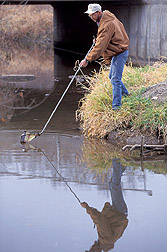Texas SWAT Team Helps Clean the World's Water |
|
|
|
When SWAT talks, the State of Texas listens. In fact, much of the world listens. SWAT is a computer model that tells where in a watershed a water pollution problem is coming from and what to do about it. SWAT stands for Soil and Water Assessment Tool, a name that belies its practical use to farmers, ranchers, water quality managers, and legislators. The model points to solutions, which in turn leads to adoption of conservation practices around the world. In Texas alone, where SWAT was developed by a team of ARS researchers, many people who have never heard of a computer model are benefiting from it. People in the Fort Worth metropolitan area, for example, will have a longer lasting and less costly water supply because of reduced sedimentation in reservoirs. Lake Aquilla, a drinking-water reservoir in central Texas, will not die prematurely. And in parts of west Texas, the drought's effects have been eased a bit. In most of these cases, Texas legislators, water districts, and river authorities were impressed enough by SWAT numbers to pay part of the costs for farmers in these areas to apply conservation measures that SWAT showed would work. These included terracing and other erosion-control measures to hold soil in place and slow its journey into reservoirs; better nutrient management on agricultural land and on confined animal-feeding operations to prevent algal blooms that impart off-flavors to water; and removal of juniper and mesquite brush to increase stream flow in drought-stricken areas of Texas. All these examples came about because an ARS team—agricultural engineers Jeffrey G. Arnold and Kevin W. King and agronomist James R. Kiniry, all with the Grassland Soil and Water Research Laboratory in Temple, Texas—developed SWAT and handed it over to scientists and engineers with USDA's Natural Resources Conservation Service (NRCS) and the Texas Agricultural Experiment Station (TAES). They use the model to analyze watersheds. Examples of success multiply with each user—and this ARS team has shared the model with thousands of users all over the world. The team used 30 years of ARS research data to construct the model and then worked closely with people from TAES and NRCS to make sure their product would be useful. "It had to result in cleaner water, longer lived reservoirs, and healthier farms and landscapes, or it would have been nothing more than an academic exercise," Arnold says. He can visit many watersheds in central and west Texas alone and see the tangible benefits of the model's calculations.—By Don Comis, Agricultural Research Service Information Staff. This research is part of Water Quality and Management, an ARS National Program (#201) described on the World Wide Web at http://www.nps.ars.uda.gov. Jeffrey G. Arnold, Kevin W. King, and James R. Kiniry are with the USDA-ARS Grassland Soil and Water Research Laboratory, 808 E. Blackland Rd., Temple, TX 76502; phone (254) 770-6500, fax (254) 770-6561. |
|
"Texas SWAT Team Helps Clean the World's Water" was published in the October 2002 issue of Agricultural Research magazine. |







